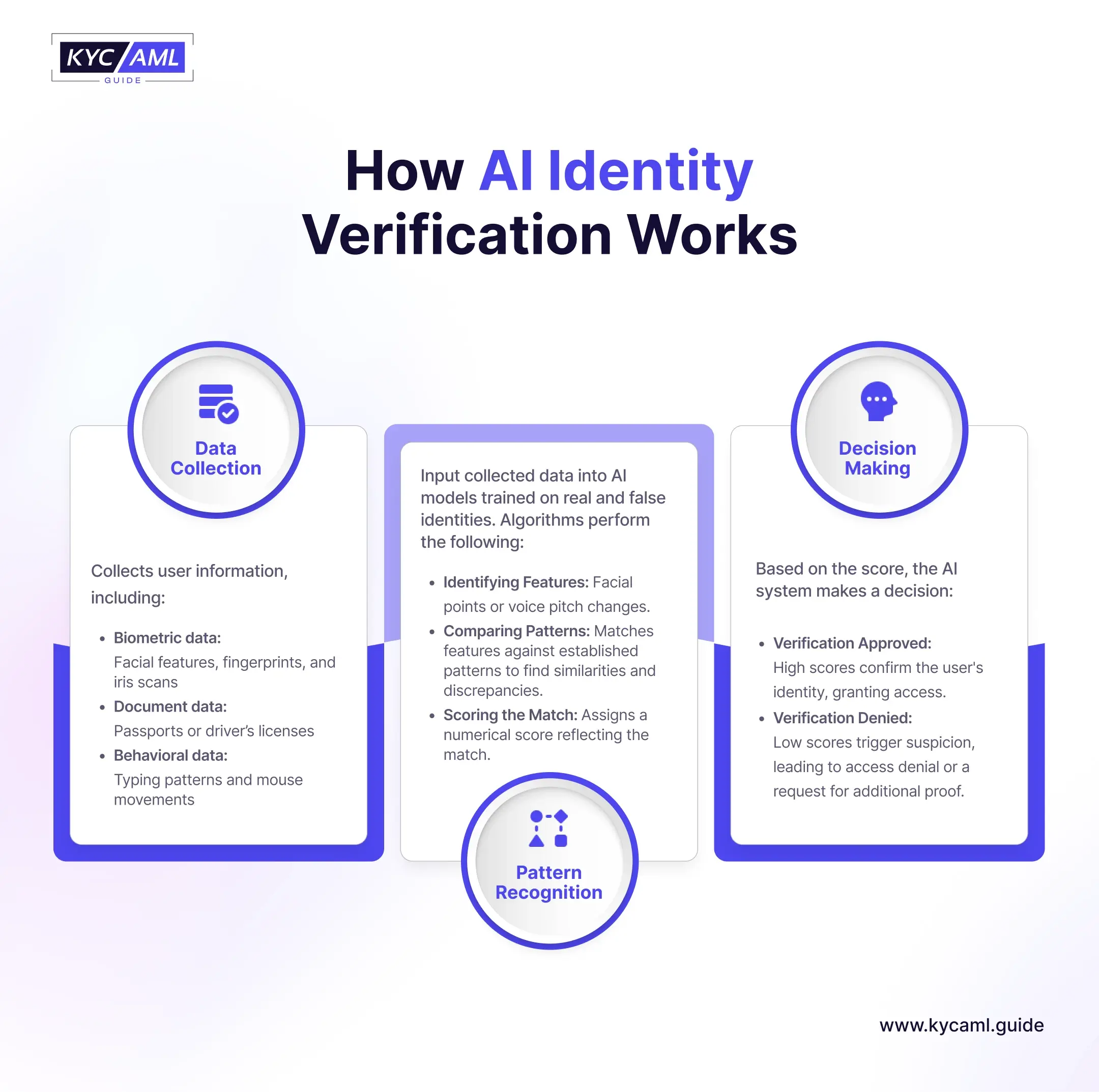What is AI ID verification?
The use of artificial intelligence to verify the customer’s identity is AI identity verification. The traditional methods use security questions, physical documents, passwords, and PINS. now with the help of artificial intelligence everything such as documents, faces, and typing patterns can get scanned in no time.
Maintaining your customers’ digital identity anywhere, anytime, on any device is a big undertaking. Sensitive and complex information is susceptible to human error if left with humans. The identity verification process is faster and more efficient and inherent biases are reduced by using artificial intelligence and machine learning (ML) technology. It helps small and medium-sized enterprises (SMEs) to multinational companies of all sizes, to meet local compliance needs and verify the customer’s identity.
Billion codes are powering a million transactions nowadays. Artificial intelligence is the primary way to eliminate bias, reduce human error, and collect data to quickly respond to emerging threats. This provides companies with sufficient information to manage future threats. Biometric verification has become a powerful tool for better identification of customers as identity verification has moved online. It is also used to meet KYC and AML compliance requirements.
The following technologies use automated AI identity verification:
- Biometric verification involves facial recognition, fingerprint, or voice to verify a customer’s identity. Over time passwords or PINs are replaced by biometric authentication as they are susceptible to fraud and malicious interference. Artificial intelligence is the key factor for biometric authentication for great success in big organizations.
- Automated AI Document Verification scans and validates government-issued identification documents to check the authenticity of the documents.
- Background check of public records for felonies, driving violations, and other warning signs.
- Anti-spoofing technologies to detect deep fakes, synthetic ID fraud, Liveness detection, behavioral analysis, and multimodal verification.
- The latest AI analysis techniques rely on encryption to protect user data stored in cloud databases.
- AI models rely on data; the better it gets. Therefore, integrating your company’s data-providing databases allows you to train and adapt AI models specifically for your needs.
How AI Identity Verification Works?
AI ID verification is a quick and convenient process. The automated Automated Identity Verification in 4 Steps is as follows:
- Data Collection
- Pattern Recognition
- Decision Making
- Extra Check
In some cases, there is a need for extra checks to verify the additional information such as a video chat.

The Benefits of Automated Identity Verification
Here are some ways artificial intelligence enhances and improves business security:
Greater accuracy
AI ID verification provides greater accuracy by integrating biometrics such as facial recognition, iris scanning and fingerprint scanning making it more difficult for fraudsters to do illegal activities. Moreover, it reduces the wait time by improving the speed and streamlines the high volume of verification requests.
Scalability
Automated systems can process large numbers of verification requests simultaneously they are ideal and scalable for large-scale applications such as e-commerce.
Cost-effectiveness
AI identity verification reduces the need for manual checks and saves money. AI ID verification also reduces losses due to criminal activity.
Behavioral Analysis
Behavioral analysis means looking at how the user behaves while creating the profile. Automated systems help identify potential hazards by looking at login times, locations, and suspicious activities.
Continuous Monitoring
Real-time AI identity verification identifies and analyzes user data and behavior by focusing on biometric reading changes, login location, and pattern of transaction.
Reduced Human Error
With the help of AI algorithms such as unique biometric characteristics, large data sets are processed more accurately than humans. This reduces the chance of failed identity verification. It can detect the most difficult deception attempts, which a person may not be able to detect due to the ability of AI to learn and adapt to new attack vectors.
Quick Response Time
Users no longer have to wait for manual identity verification with AI-powered verification. Analyzing biometric features using artificial intelligence eliminates the need to move information to the remote server.
Adaptability to Evolving Threats
New data and insights are regularly updated in an automated system. Real-time AI monitoring helps to quickly identify and respond to emerging threats.
Challenges of AI ID verification
However, there are also some challenges in using AI algorithms for identity verification.
- The most important concern is privacy and data security as due to cyberattacks, there is a threat of identity data being misused.
- AI identity verification can also lead to potential bias by discrimination based on race and gender.
- Also, there is a need to strongly enforce and implement the General Data Protection Regulation (GDPR).
Finally,
AI identity verification is not a silver bullet that alone can solve fraud and privacy problems. In the identity verification process, human interaction plays an important role. It helps to train and solve complex cases that automated systems and machine learning models struggle to solve. So the solution is to let your automated identity verification handle most of your organization’s day-to-day identity verification tasks, giving your security team time to handle complex and highly nuanced fraud cases that require a human and someone who knows your business well.
However, if you have a problem finding a good AI-powered identity verification solution. The KYC AML guide can help you by providing research-based KYC technology buying consultancy.





